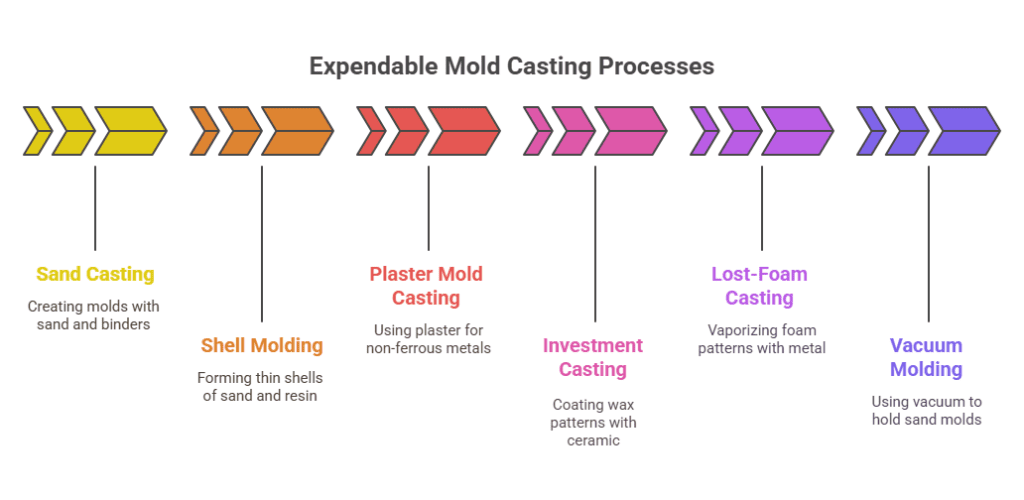Expendable mold casting is a metal forming process where the mold gets destroyed to remove the finished part. The mold is made from materials like sand, plaster, or ceramic that break apart after the metal cools and hardens.
This process differs from permanent mold casting where the same mold creates multiple parts. In expendable mold casting, you need a new mold for every single part you make. While this sounds wasteful, it actually allows you to create complex shapes that would be impossible to remove from a permanent mold.
The basic process involves 4 main steps. First, you create a pattern of the part you want to make. Then you form the mold around this pattern using your chosen mold material. After removing the pattern, you pour molten metal into the cavity. Finally, you break the mold to get your finished metal part.

Sand casting uses a mixture of sand and binding agents to create the mold. To make a sand mold, you pack specially prepared sand around a pattern in a two-part box called a flask. The sand mixture typically contains 90% sand, 7% clay, and 3% water.
This method works for parts ranging from a few ounces to several tons. Sand casting produces about 60% of all metal castings in the United States. The process costs less than other casting methods because sand is cheap and readily available.
Shell molding creates a thin shell of sand and resin around a heated metal pattern. The pattern heats to temperatures between 350-700°F. When you dump the sand-resin mixture onto the hot pattern, it forms a shell about 0.25 to 0.5 inches thick.
This process produces better surface finishes than regular sand casting. The dimensional accuracy reaches ±0.005 inches per inch. Shell molds also require less sand, making them lighter and easier to handle.
Plaster mold casting uses gypsum plaster instead of sand to form the mold. To create the mold, you mix plaster of Paris with water and additives like talc or silica flour. The mixture sets around the pattern in about 15 minutes.
This method only works with non-ferrous metals like aluminum, zinc, and copper alloys. The plaster breaks down at the high temperatures needed for iron or steel. Plaster molds produce excellent surface finishes with details as fine as 0.001 inches.
Investment casting creates extremely precise parts by coating a wax pattern with ceramic slurry. The process starts when you inject wax into a metal die to form the pattern. You then dip the wax pattern into ceramic slurry multiple times, building up layers.
After the ceramic hardens, you melt out the wax in an autoclave at 200-375°F. This leaves a hollow ceramic shell ready for metal pouring. The ceramic shell can withstand temperatures up to 2,000°F. Investment casting achieves tolerances of ±0.003 inches for the first inch.
Lost-foam casting uses expanded polystyrene foam patterns that stay in the sand mold during pouring. The molten metal vaporizes the foam pattern as it fills the mold cavity. This eliminates the need to remove the pattern before pouring.
The foam patterns connect together to form complex assemblies. You can glue multiple foam pieces to create intricate internal passages. The process needs no draft angles since you never pull the pattern from the sand.
Vacuum molding pulls air from the sand mold to hold it together without binders. A thin plastic film covers the pattern and sand. When you apply vacuum, atmospheric pressure compresses the sand into a rigid mold.
The vacuum pressure typically ranges from 10-14 inches of mercury. This creates enough force to hold sand grains together during metal pouring. After the metal solidifies, you release the vacuum and the sand falls away.
This process produces no gas defects since there are no organic binders to burn. The sand is completely reusable because it contains no chemicals.
